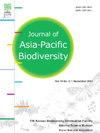Food habits of the exotic lizard Diploderma polygonatum polygonatum (Agamidae, Squamata, Reptilia) at a world heritage site, Yakushima Island, Japan
IF 0.7
Q4 BIODIVERSITY CONSERVATION
引用次数: 0
Abstract
This study investigated the dietary components of an exotic lizard, Diploderma polygonatum polygonatum, at the Yakushima Island World Heritage Site in southern Japan. A total of 430 individuals of various invertebrate species were found in the stomachs of 42 lizards. The most abundant order of prey animals was Hymenoptera (303 individuals in 38 lizards), followed by Coleoptera (36 individuals in 18 lizards) and Lepidoptera (24 individuals in 15 lizards). DNA barcoding was applied to 135 dietary items, and a total of 59 sequences were confirmed. BLAST searches showed that 33 of these 59 sequences presented more than 95% identity to known sequences in the database. These results showed this arboreal lizard captured invertebrates from both ground and arboreal habitats in the introduced area. Although no species on the Japanese Red List were identifiable in the stomachs of the lizards, the database of invertebrate DNA was insufficient to identify the dietary components of this predator at a World Heritage site.
日本屋久岛世界遗产地外来蜥蜴黄精双足蜥的饮食习性(无足科,有鳞目,爬行纲)
本研究调查了日本南部屋久岛世界遗产地的一种外来蜥蜴——多精蜥的饮食成分。在42只蜥蜴的胃里共发现了430个各种无脊椎动物的个体。被捕食目以膜翅目最多(38只中有303只),其次是鞘翅目(18只中有36只)和鳞翅目(15只中有24只)。利用DNA条形码技术对135个膳食项目进行分析,共确定了59个序列。BLAST检索显示,这59个序列中有33个序列与数据库中已知序列的同源性超过95%。这些结果表明,这种树栖蜥蜴在引进地区的地面和树栖栖息地捕获无脊椎动物。尽管在日本红色名录中没有发现这种蜥蜴的胃中有任何物种,但无脊椎动物DNA数据库不足以确定这种世界遗产地食肉动物的饮食成分。
本文章由计算机程序翻译,如有差异,请以英文原文为准。
求助全文
约1分钟内获得全文
求助全文
来源期刊

Journal of Asia-Pacific Biodiversity
Agricultural and Biological Sciences-Insect Science
CiteScore
1.70
自引率
12.50%
发文量
94
审稿时长
27 days
期刊介绍:
The Journal of Asia-Pacific Biodiversity (previous title was Journal of Korean Nature) is an official journal of National Science Museum of Korea (NSMK) and Korea National Arboretum (KNA). The scope of journal is wide and multidisciplinary that publishes original research papers, review articles, as well as conceptual, technical and methodological papers on all aspects of biological diversity-its description, analysis and conservation, and its application by humankind. This wide and multidisciplinary journal aims to provide both scientists and practitioners in conservation theory, policy and management with comprehensive and applicable information. However, papers should not be submitted that deal with microorganisms, except in invited paper. Articles that are focused on the social and economical aspects of biodiversity will be normally not accepted.
 求助内容:
求助内容: 应助结果提醒方式:
应助结果提醒方式:


